Report
 }
}
Executive summary
This is the sixth consecutive year that we’ve tracked the shopping behavior of Chinese consumers. Our continuing research has given us a valuable long-term view across 106 fast-moving consumer goods (FMCG) categories purchased for home consumption in China. As in each of the past six years, we conducted a deep analysis of the key 26 categories that span the four largest consumer goods sectors: packaged food, beverages, personal care and home care.1 Combined, these sectors represent 80% of China’s FMCG purchases.
As in previous years, we based our research on a panel of 40,000 urban households equipped with scanners to track their FMCG purchases for at-home consumption.
In last year’s report we introduced readers to the phenomenon that China’s FMCG market operates at two distinct speeds: fast and slow. This year we continued to examine the two-speed pattern through three lenses:
- the product category lens
- the channel lens
- the local vs. foreign brand lens
For the first time this year, we also studied the FMCG market with a new lens: the out-of-home (OOH) consumption of food and beverages.
- Working with Kantar Worldpanel, we enlisted 4,000 Chinese individual consumers in Tier-1 and Tier-2 cities to track their food and beverage purchases for consumption outside of their homes using smartphones.
- In combination with additional data sources, we conducted an in-depth analysis of the overall eating and drinking channel dynamics.
The results helped us understand the dimensions of a significant trend: More Chinese consumers are substituting out-of-home consumption (including consumption on the go, restaurant food delivery and dining out) for at-home consumption. This shift helps explain why food and beverage in the main grocery channels has slowed down so much since 2014, unlike home and personal care consumption.
When we introduced the two-speed insight to our readers last year, we showed, for example, how yogurt sales boomed while confectionary struggled. Convenience and online purchases flourished while hypermarkets suffered. Domestic brands thrived on average, while many multinational brands stalled.
This two-speed insight struck a chord among companies, and many have begun using it as a starting point for revising their strategy by revisiting their portfolios. They’ve adjusted their view of China as a single, high-velocity environment and now aim to grow in the fast-speed markets while managing for cost in low-speed arenas.
This year we found the two-speed growth continuing, while annual growth in FMCG value for home consumption maintained its slowdown in 2016 across all sectors we studied, hitting a five-year low. This is due to a combination of almost flat volume growth and a deceleration of price growth, which dragged down overall FMCG value growth.
Let’s look at product categories first. Value growth of FMCG sales for home consumption totaled 3.0% in 2016; however, the growth rates for food and beverage categories are dramatically different than for home and personal care. It’s to the point where food has grown by 0.5% and beverages by 2.0%, while personal care and home care increased by 10.5% and 3.5% respectively, representing an improvement over 2015.
Penetration rates for brands in most categories are plateauing or dropping.2 Average household penetration for the 26 categories is 81%, a decline from 83% last year. Among the reasons:
- Most categories have now reached the distribution that they need in urban China. Mass expansion is nearly over and brands face the major challenge of increasing repeat sales and premiumization (selling at price increases higher than the rate of inflation) in order to grow.
- Categories perceived as healthy or hygiene-related achieved high and growing penetration. They include yogurt, shampoo, facial tissue, packaged water and diapers. By contrast, categories perceived as less healthy—such as confectionary (chocolate, candy, chewing gum) and instant noodles—all dropped in penetration.
Personal care categories and premium stock-keeping units (SKUs) throughout many categories continue to achieve robust value growth as Chinese shoppers who can afford it demonstrate that they’re willing to pay for higher-quality goods.
In the years ahead, companies that do the best job of simultaneously operating at two speeds will be positioned to outpace rivals. This is already becoming apparent in areas like instant noodles, a category that appeared to have an unpromising future. But leading brands such as Master Kong and Uni-President may be turning the tide: They’re now targeting white-collar shoppers with new premium product ranges, while compensating for declining volumes among their traditional blue-collar shoppers by raising prices on mass products. We expect to see more moves like these—it will be the way to grow and flourish for brands in China.
This year we saw a continuing geographic trend. China’s southwestern and central provinces have maintained their status as the major growth engines for FMCG sales. This is a result of an increase in number of households, fueled in part by the urbanization of inland provinces as many industries shift from coastal regions.
We found a continuation of the two-speed pattern in channel growth as well. The most dramatic situation: Hypermarkets declined by 2% and supermarkets or minimarkets decelerated to 2%. By comparison, convenience stores increased by more than 7%. The e-commerce channel continued to skyrocket, growing by more than 52% in value. Online now represents 7% of all FMCG sales—it doubled its share of the FMCG market in the last two years. Online is still most popular in Tier-1 cities, but lower-tier cities are quickly catching up. And the three clusters of categories we identified last year, based on their digital penetration trajectory since 2012, continue to hold true:
- Skin care, shampoo, diapers and biscuits have high online penetration and a strong upward trend.3
- Beverages, fabric softener and chewing gum have a low online penetration, reflecting characteristics that limit their online potential.
- A middle cluster of categories, spanning most personal care, home care and packaged food, is being aggressively promoted for online growth by top brands and e-commerce retailers.
Finally, we’re still seeing the two-speed effect in the ongoing battle between foreign and local brands. In 2016, local companies maintained their ability to gain share over foreign competitors, measured on an aggregate basis. In fact, foreign brands captured share in only 4 of the 26 categories we studied, and lost in 18 (while 4 categories did not change, or barely changed). Local companies grew by 8.4%, while foreign brands grew only by 1.5%.
- In general, domestic players are winning in personal care; when foreign companies gain share, it’s often in food and beverage categories.
- A host of well-recognized reasons suggest why Chinese companies do so well at home. Among them: local players’ entrepreneurial governance and Founder’s Mentality®4, their knowledge of local taste and their ability to make quick decisions and just as quickly execute those decisions—including those that help them innovate or embrace digital opportunities.
Since 2014, we’ve seen the divergence between food and beverages, and personal care and home care, a situation that convinced us to look more closely at out-of-home food and beverage consumption. What we learned is that Chinese consumers are switching from meals prepared at home to dining out and food delivery. Consider these findings:
- When we look at 11 main categories of food and beverages that overlap between home consumption and OOH consumption purchased from convenience stores across Tier-1 and Tier-2 cities, 85% of these purchases are for out-of-home consumption.5
- Food delivery grew by 44%, while out-of-home dining rose by 10% in 2013-16.
- The boom in online-to-offline (O2O) food delivery, which achieved 40% to 50% annual growth over the past three years, is fueling the growth in food delivery.
China’s changing habits in food and beverage consumption can raise hopes, and help dictate important moves, in each of these channels. For example, the majority of beer purchased in convenience stores and groceries in Tier-1 and Tier-2 cities now is consumed outside the home. That raises the stakes for both to tailor products for out-of-home consumption through such proven methods as adapting packaging and pack sizes. With a growing portion of their sales intended for on-the-go consumption, convenience stores can stock more food in packages designed for quick eating. With most of hypermarket beverage sales intended for home consumption, it makes sense for hypermarkets to focus on bulk packaging.
Some brands are aggressively addressing these changes. For example, Unilever and Fonterra have invested to build food service divisions dedicated to selling ingredients to restaurants. Those divisions all are enjoying double-digit growth.
These trends can help FMCG companies not only better understand market directions but also determine which trajectory their brands are on and how to set the right strategy for that trajectory. Even in the two-speed scenario, shoppers display predictable purchase patterns, and brands can outperform rivals by identifying those patterns.
Companies and brands can win by:
Embracing two-speed growth and simplifying and rationalizing their business portfolio. Companies need to look at their product and channel mix with the two-speed lens. Companies with significant exposure to low-speed categories or channels have no choice but to embark on a transformation. They can introduce new premium ranges to meet consumers’ increasing demand for healthy and quality products. We have seen leading companies trying to change the game in the juice and instant noodle categories, for example. Finally, they need to continue efforts to develop digital capabilities and more broadly design their business functions with a full-channel vision.
At the same time, both brands and retailers can adjust their strategy to profit from the growing trend of consumers substituting out-of-home consumption for at-home cooking. Food and beverage companies can advance by serving business-to-business (B2B) customers such as restaurants and bars. All retailers can revamp store designs to accommodate the huge need for on-the-go packaging, ready-to-eat products and delivery. In addition, retailers need to continue to restructure their store portfolio and invest in their digital capabilities to offer seamless O2O services to their consumers.
Full report
China’s two-speed growth continues across product categories
To see the strongest evidence of China’s two-speed trajectory in fast-moving consumer goods (FMCG), consider the distinctly different sales growth patterns for food and beverage brands compared with personal and home care brands. The total amount that urban shoppers spent on food and beverages consumed at home grew by an unimpressive 0.1% in the final quarter of 2016 vs. 8.6% growth in personal and home care sales. Indeed, as China’s FMCG sales growth began slowing five years ago, a clear trend emerged: Consumers significantly increased their spending on personal and home care goods, such as makeup and facial tissue, while appearing to cut back on food and beverages (see Figure 1).
Value growth for FMCG in China continued to decelerate, reaching a five-year low of 3.0% in 2016, which represents a further slowdown of 0.6% compared with 2015. The slowdown of growth results from the double whammy of a 0.6% increase in volume growth and tepid increases in average selling price just above the inflation rate across all FMCG categories. In 2016, prices rose by 2.4%, compared with 4.4% a year earlier (see Figure 2). The stalled performance isn’t caused by slowing growth in the number of urban households, which continues to increase steadily. Instead, it’s due to a slowdown in average spending per household on FMCG products, which decelerated to 0.7% in 2016, much lower than the growth of disposable income.
However, these overall findings mask the reality of China’s two-speed trajectory.
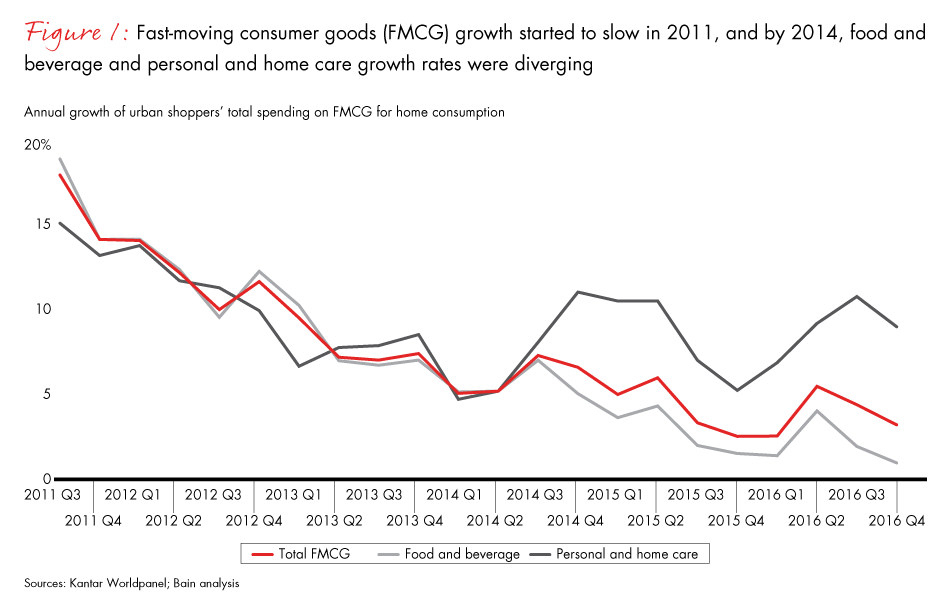
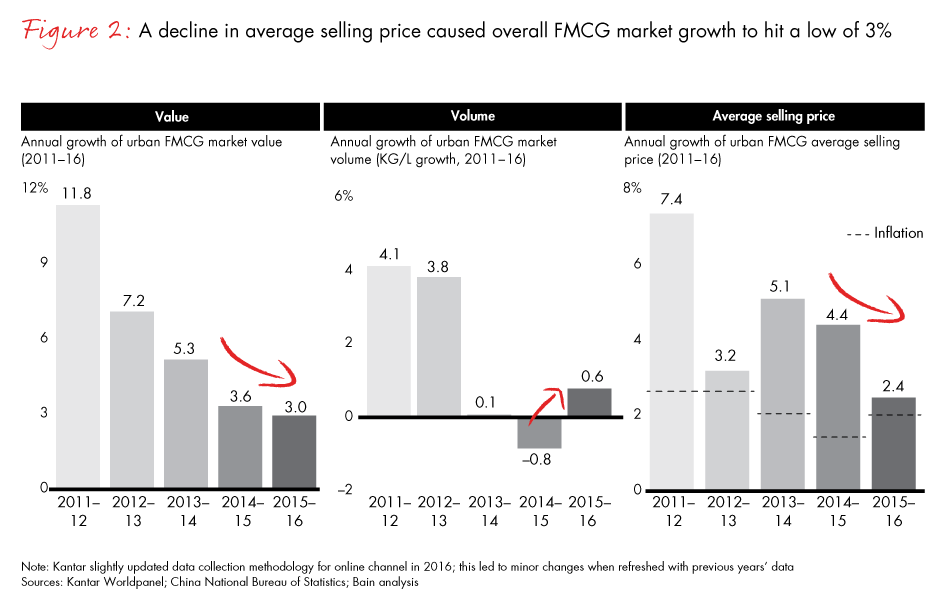
Let’s look first at the slow-speed categories. Packaged food remained stagnant in value growth, gaining only 0.5% (see Figure 3). Among packaged foods, confectionary categories took the hardest hit, with value growth of candy, chocolate and chewing gum sinking by 6.0%, 9.0% and 15.0%, respectively. In addition to the general shift away from foods that are perceived to be less healthy, other contributing influences led to the underperformance in these categories. For example, candy and chocolate traditionally are popular as gift items. Now, as more Chinese travel during holidays, there are fewer opportunities to offer gifts to friends and family at home gatherings. Meanwhile, beverage growth slowed dramatically—from 5.5% growth in 2015 to 2.0% in 2016—due in part to much lower average prices for milk and Chinese spirits.
Some food and beverage categories are benefiting from innovative moves aimed at reversing the downward trend. Consider instant noodles, a category that has witnessed an average annual decline of 10% for the past two years. Leading players like Master Kong and Uni-President have introduced more premium product ranges—noodles with better-quality ingredients in more sophisticated packaging, for example—to address the higher demands of white-collar consumers. At the same time, these brands are benefiting by adjusting the prices on lower-end products sold to their traditional blue-collar consumer base, a move that helps them compensate for increased raw material prices and sustain value growth. The instant noodle category is an important one to watch. Imported brands from Japan, Korea and throughout Southeast Asia—typically with higher prices than domestic brands—are gaining popularity, with a major boost from social media, such as the much-viewed video clips of instant noodle tastings from around the world. There’s a distinct effort to appeal to younger, digital-savvy consumers.
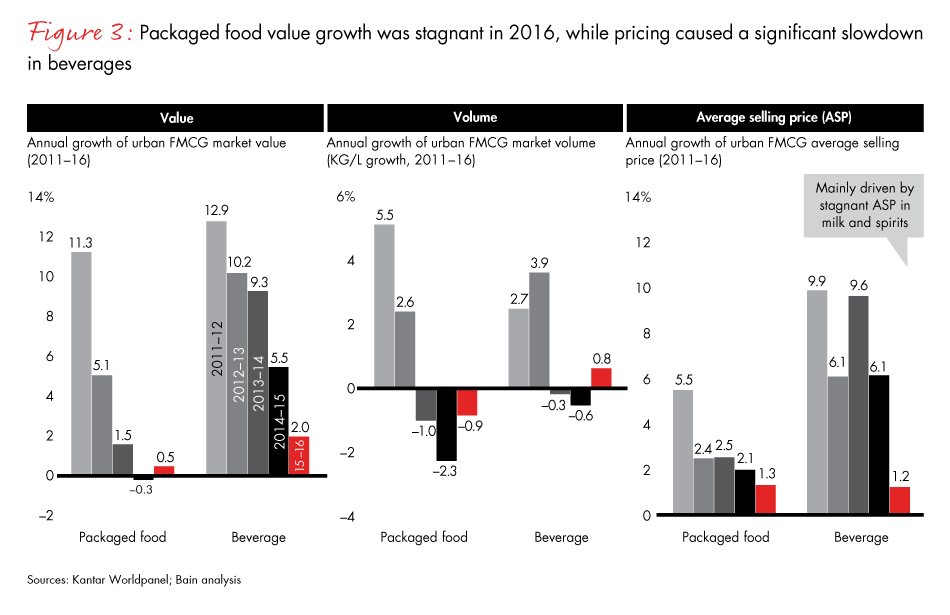
Other factors come into play, too. Infant formula recovered from its negative 3% growth last year to enjoy more than 6% growth this year. Contributing to the turnaround: The government’s new second-child policy, introduced in the beginning of 2016, is starting to show remarkable results.
While packaged food categories may be losing ground overall, others are enjoying strong momentum. For example, the value of personal care rose 10.5% and home care grew by 3.5% in 2016, the result of a resurgence in volume and high prices (see Figure 4). These categories benefit from critical trends among Chinese consumers, such as an increasing attention to health and wellness.
Indeed, China’s consumers are continuing to show a preference for healthy goods or for a better-quality life, a phenomenon enabled by higher average incomes. The value growth for packaged water was 17.3%, and skin care value growth rose by 13.6% in 2016 (see Figure 5).
We observed strong premiumization across personal care categories. For example, in beauty (makeup and skin care), luxury brands such as Armani and YSL have performed very well this year in China. In the toothbrush category, premiumization is the result of a rising awareness of oral hygiene and the increasing popularity of electric toothbrushes such as those manufactured by Philips. Meanwhile, facial tissue grew in volume as more Chinese consumers substituted it for toilet paper in such common household uses as wiping tables. Toilet tissue is premiumizing as more consumers trade up from two-ply to three-ply tissue.
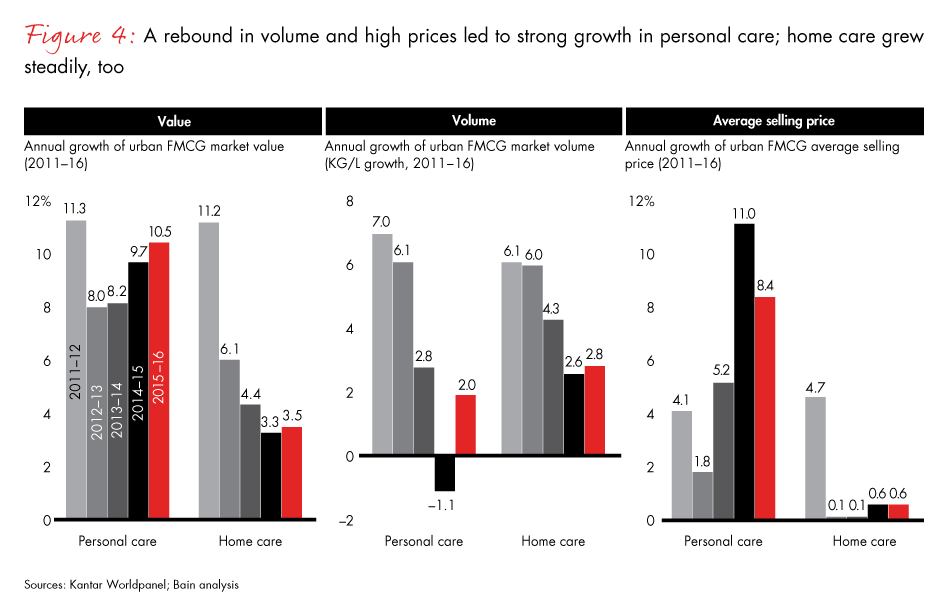
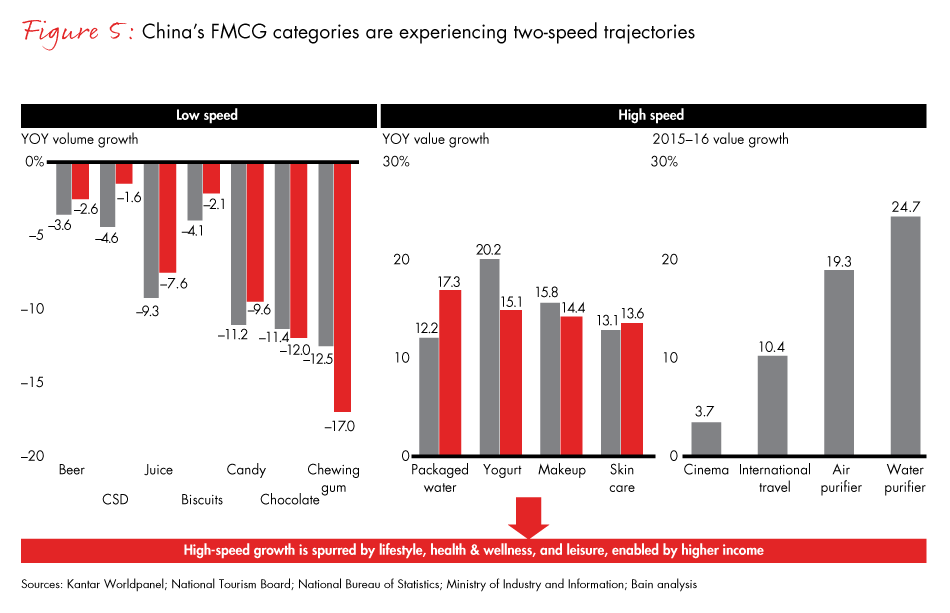
Within many product categories, we also see two-speed in play: Premium segments now outpace mass segments. This is especially true in packaged water, yogurt, skin care, makeup, fabric care, instant noodles, kitchen cleanser, infant formula, milk and ready-to-drink tea (see Figure 6)—further evidence that Chinese consumers will pay for healthy goods or to improve their lifestyle.
The overall growth figures in FMCG value, volume and average selling price become even more dramatic when you consider the massive role that online sales is now playing (see Figure 7). In fact, e-commerce accounted for more than three-fourths of the total growth in value in 2016. Without the boost from online, FMCG value would have inched up by less than 1% in 2016.
Most categories are reaching a penetration plateau and are experiencing declining penetration rates (see Figure 8). Average penetration for the 26 categories dropped to 81% from 83% in 2015. Only seven categories grew in penetration—yogurt, makeup, shampoo, conditioner, facial tissue, packaged water and diapers—all of them health- and hygiene-related. Penetration saturation reflects how most categories have reached the distribution that they need in urban China. Until now, most brands grew by opening stores or points of distribution. Now the period of mass expansion is over, and brands need to reach their growth targets by focusing on penetration, by boosting brand repeat sales and through premiumization—pursuing average selling price increases that are higher than the rate of inflation.
As widespread distribution results in plateauing or declining penetration, many brands compensate by taking two approaches to premiumization: increasing the volume share of premium SKUs or raising prices of those SKUs. To see premiumization in action, look at the success of some juice brands commanding solid sales increases despite declining sales and volume in the overall category. Leading companies such as Weiquan and Nongfu introduced new juice ranges—healthy “Body Management’’ juice and not-from-concentrate (NFC) juice, respectively. Both companies enjoyed over 20% growth in 2015–16.


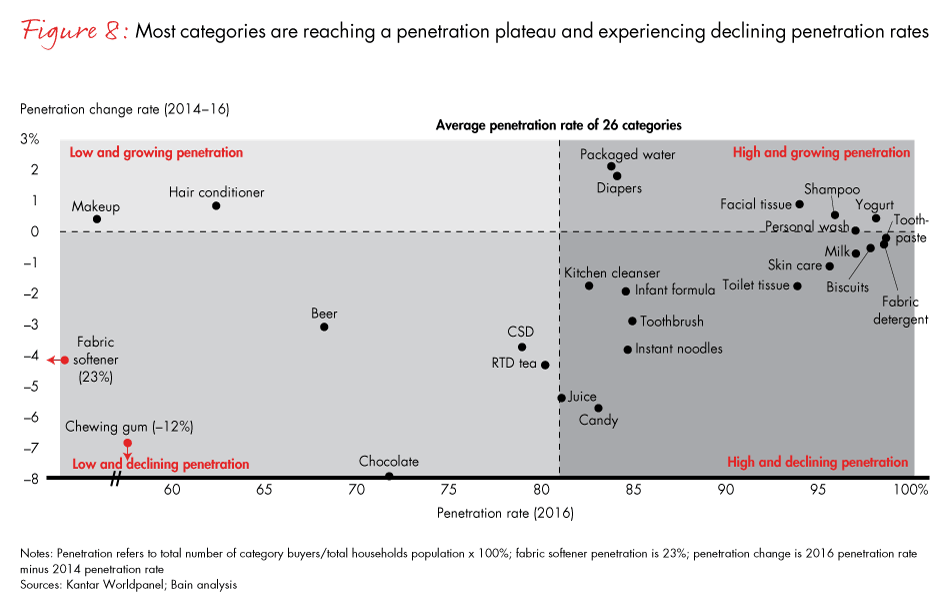
While most FMCG categories are continuously premiumizing, only a few are able to increase penetration at the same time. Among those categories: packaged water, shampoo, conditioner, yogurt and makeup. Packaged water benefits from the National Food Safety Standard of Natural Mineral Water, which led to the introduction (and heavy marketing investment) of new product ranges, most of them premium brands. A common strategy for improving volume at the expense of average selling prices is to offer products on promotion. This is especially popular among commoditizing categories—those with price increases that lag inflation. These categories are increasingly purchased during promotions. Personal care and home care categories tend to offer more promotions (see Figure 9). Overall for the 26 categories, 22% of FMCG goods are purchased on promotion. But the rate was 33% for facial tissue and 39% for diapers in 2016.
The offline promotion rate increased significantly in the last two years, from 14% in 2014 to 21% in 2016; this is mostly the result of offline channels fighting back to boost traffic in their stores against the online platforms.
The online promotion rate remained high at around 38% over the last three years from the continuous growth of premium and imported products, which typically involve less promotion.

Two-speed growth by geography
Southwestern and central provinces continue to serve as the growth engine for brands in China (see Figure 10). Six of those provinces experienced FMCG growth in excess of 7% in 2016: Sichuan, Shaanxi, Shanxi, Guangxi, Hunan and Hubei. This resulted from an increase in number of households, fueled in part by higher economic growth. FMCG consumption growth is boosted by the urbanization of inland provinces as many industries shift from coastal regions. Blue-collar workers continue to be a massive force in China’s FMCG market.
Two-speed growth in retail channels
Our sixth annual study of Chinese shopper behavior for home consumption shows the continuing shifts in retailing. Online and convenience store channels maintain strong momentum, while big-box retailers lose steam (see Figure 11). Unsurprisingly, e-commerce led the pack, growing by more than 52.0%. Online now represents 7.0% of total FMCG sales. Convenience stores, steadily serving the needs of busy urban consumers, grew by 7.4%, adding such new incentives as in-store pickup of products bought online from other retailers. The hypermarkets that once defined robust growth declined by 2.0%, and the once-flourishing super or mini format grew by 2.0%, about the same rate as inflation. While their share is slowly shrinking, those two formats still account for more than half of the FMCG market.
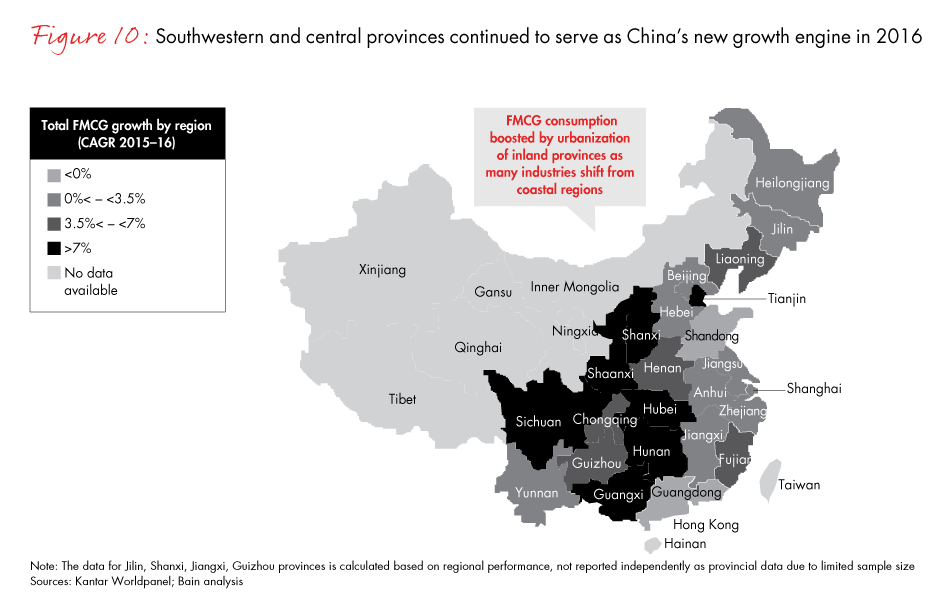

What’s behind the changing channel preferences? Consider the challenges facing hypermarkets. In increasing numbers, China’s consumers are looking for convenience, either online or offline. As a consequence, they’re making fewer and fewer trips to hypermarkets. Traffic has declined steadily since 2012 (see Figure 12). Volume per household is down, too. In 2012, the average household purchased 101.6 kilograms or liters of goods at a hypermarket. That volume dropped to 90 kilograms or liters in 2016. Meanwhile, the hypermarket landscape shows signs of saturation, with the penetration rate plateauing at 80% in 2015 and sinking to 78% in 2016.
Contrast the hypermarket situation with that of online sales in the world’s biggest online marketplace. It’s no secret that digital sales continue to skyrocket in China. The phenomenon gets particularly interesting when you look at some of the ways the growth is happening. For example, online still is most popular in Tier-1 cities. But Tier-3 and Tier-4 cities are rapidly catching up (see Figure 13). In 2015, Tier-3 and Tier-4 cities’ online sales contributed to just 4% of all FMCG spending in these cities, equivalent to Tier-1 cities’ online contribution in 2012. However, in 2016 the online sales contribution for Tier-3 and Tier-4 cities reached close to 7%, equivalent to Tier-1 cities’ 2014 level. In other words, those lower-tier cities are only two years behind, and catching up at an accelerating pace.
Baby and beauty categories continued achieving high online penetration and share of value in 2016 (see Figure 14). Among all categories, diapers stands out, with an online penetration of 60%. In fact, online sales represent 43% of diapers’ total sales. Shoppers go online for these baby and beauty products in search of variety, and imported brands. They’re looking for safe, high-quality brands. In addition, baby categories are typical “loyalty” categories for which the online channel is a convenient replenishment tool.
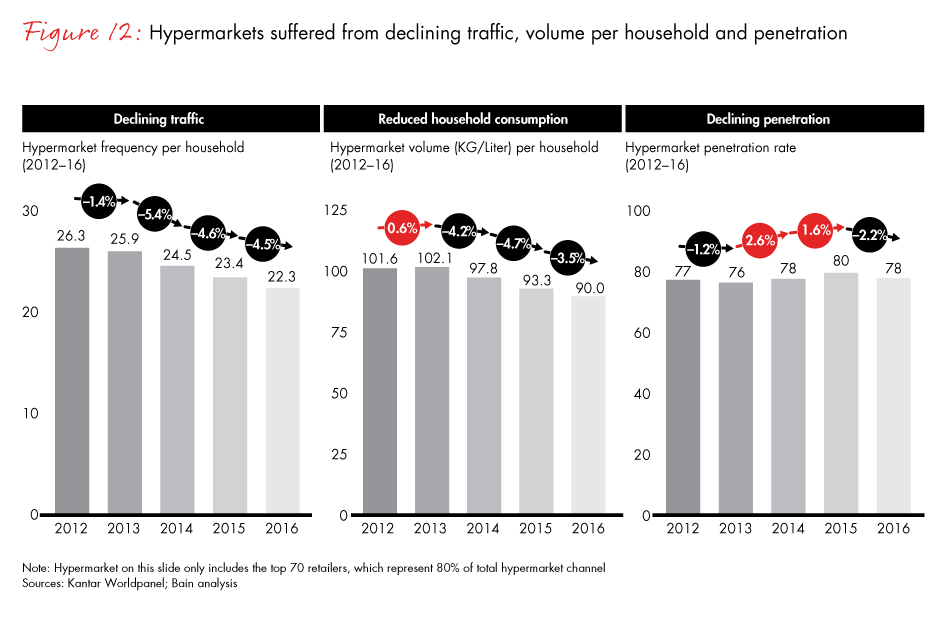

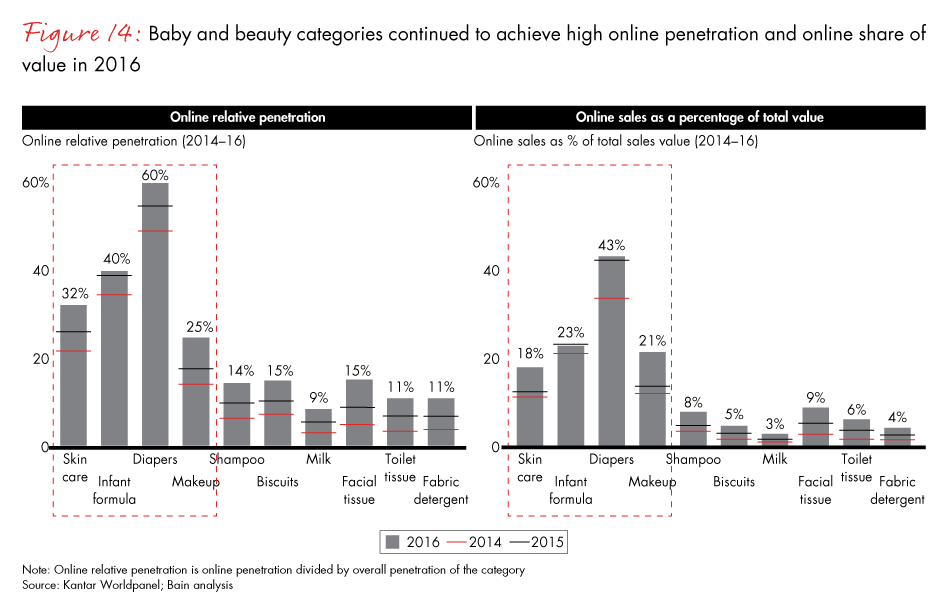
The reality is that not all categories lend themselves to online sales. As we saw last year, categories tend to form three clusters based on their digital penetration (see Figure 15). The first cluster consists of skin care, shampoo, diapers and biscuits. These categories have a high online penetration and a strong upward momentum. On the opposite end are categories like beverages, fabric softener and chewing gum, which have a low online penetration. Among the reasons for their low online penetration: Beverages are costly to transport, chewing gum tends to be an impulse purchase and, as we reported last year, fabric softener still is not widely purchased in China. There’s significant interest in the middle cluster of categories that includes most personal care, home care and packaged foods. These categories are being aggressively promoted for online growth by top brands and e-commerce retailers.
Two-speed growth for local and foreign brands
Local brands are continuing to outpace foreign brands in China; it’s another dimension of the two-speed environment. In each of our five previous studies, we detailed how Chinese companies have been gaining share over their foreign rivals on an aggregate basis in most of the 26 categories we studied (see Figure 16). Chinese companies grew by 8.4% in 2016. It’s to the point where they account for 93% of the country’s FMCG market growth. By contrast, foreign brands grew by 1.5%.
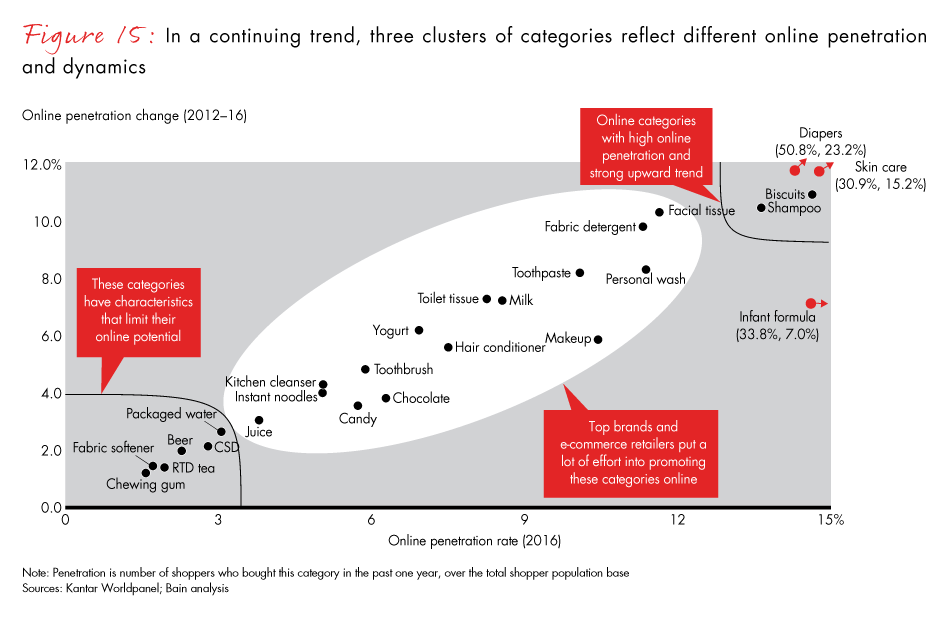
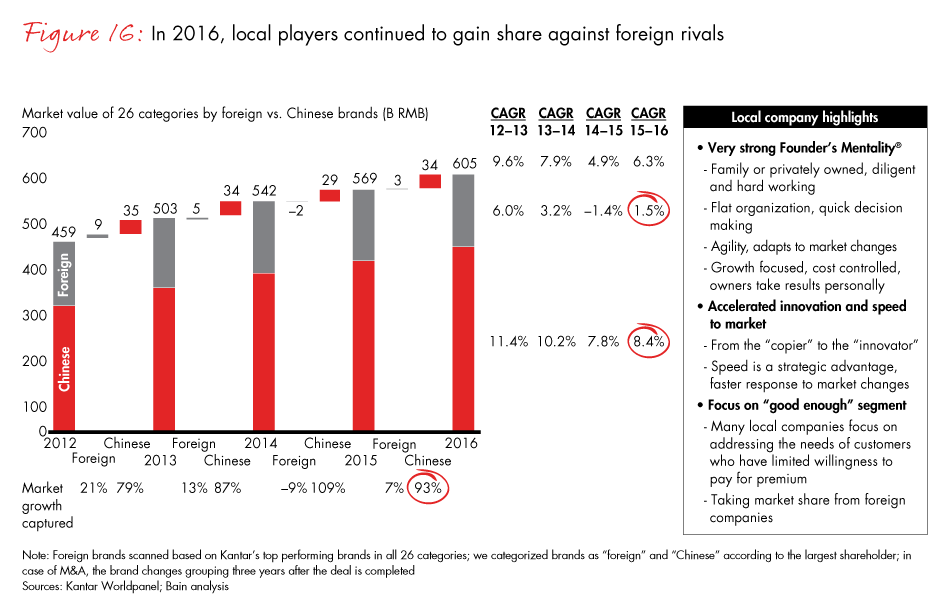
Domestic players continue to draw on the many advantages they have over foreign brands. Many of the Chinese companies benefit from a single-country focus, family ownership and agile organizations that can quickly adapt to meet changing consumer demands. That speed has helped them make the leap from copiers to innovators.
The tables were turned when multinationals were forced to play catch-up with Seeyoung’s silicone-free shampoo. Many domestic brands also are succeeding by focusing on the “good enough” segment, where consumers place relatively equal importance on price and quality, and value cost-effectiveness. That’s how Nongfu hit the sweet spot with its midrange NFC juice, filling the gap between high-end cold-pressed juice and juice made from concentrate. Chinese companies also are faster at adapting to e-commerce and social media.
Foreign brands lost share to domestic brands in 18 categories and gained share in 4 categories, while share did not change or barely changed in 4 categories (see Figure 17). The categories where domestic brands are making the most gains against foreign competitors include makeup, conditioner, shampoo and toothbrushes. Foreign companies are taking share from domestic companies in chewing gum, fabric softener, instant noodles and beer.

We should keep in mind that these numbers compare the aggregate share of foreign brands with the aggregate share of local brands across these categories, among the top 20 brands in the category. This does not mean that no individual foreign brand is gaining share; in fact, many foreign brands are doing so.
Introducing China’s booming business in food delivery and out-of-home consumption
A major change is afoot in how Chinese people prefer to consume their food and beverages. While value growth in personal care and home care maintained a healthy pace, food and beverage growth continued its steady decline. As the gap widened over the years, we decided to take a closer look at food and beverage consumption.
Kantar Worldpanel introduced its out-of-home (OOH) data panel last year to capture consumers’ food and beverage purchases for consumption outside their homes. The results for the first time helped us understand the dimensions of a significant trend: In several categories a very large amount of food and beverages is purchased for OOH consumption—in restaurants, bars, cinemas, bakeries or in convenience stores to eat on the go, for instance. Instead of preparing food at home, many Chinese consumers also are preferring restaurant food delivery or dining out. This shift provides a new lens on FMCG value growth. We will continue to monitor OOH consumption dynamics in following years’ reports.
These trends open up dramatic new opportunities for brands and retailers. Convenience and grocery channels now hold huge potential for selling food and beverages specifically for out-of-home consumption (see Figure 18). When we looked at 11 main categories of food and beverages across Tier-1 and Tier-2 cities that overlap between at-home and OOH consumptions, we realized that roughly equal amounts were purchased for each type of consumption. Further study showed that only 4% of all spending on these 11 categories for at-home consumption takes place in convenience stores. However, for out-of-home consumption, 21% occurs in convenience stores. If we look at total convenience store sales for these food and beverage categories, out-of-home consumption accounts for 85% of the sales. So the convenience channel is much more important for these categories than it is when we consider only at-home consumption. This also holds true for the grocery channel.

Both brands and retailers can take advantage of this market shift. Brands can grow volume in convenience stores by introducing pack sizes for eating or drinking on the go. Convenience stores can revamp store designs to offer more products for out-of-home consumption.
For example, look at the potential for the low-growth category of beer (See Figure 19). As one would expect, the major channel for out-of-home consumption is restaurants. However, the majority of beer sold in convenience and grocery stores is consumed out of home. This opens the door for pack-size decisions aimed at serving the out-of-home segment. By contrast, hypermarkets and supermarkets sell more beer for home consumption than for out-of-home consumption. This creates the opportunity to introduce bulk pack sizes that could boost volume and better serve consumers who drink their beer at home.
Finally, instead of cooking meals in their kitchens, more Chinese are opting to dine out or to order food delivery (See Figure 20). Our research found that while food purchased for home cooking grew by an annual 3% from 2013 to 2016, food delivery rose by 44% and dining out grew by 10%. Forward-looking brands are already benefiting from this trend. For example, the food service divisions at Unilever and Fonterra that sell ingredients to restaurants are achieving double-digit growth. Not surprisingly, private equity investors have targeted online-to-offline (O2O) food delivery aggregator platforms such as Ele.me and Meituan—a segment of the food delivery market that has grown by 40% to 50% annually since 2013, and will continue to advance along with Chinese consumers’ increasing appetite for convenience and for quality food and beverages.
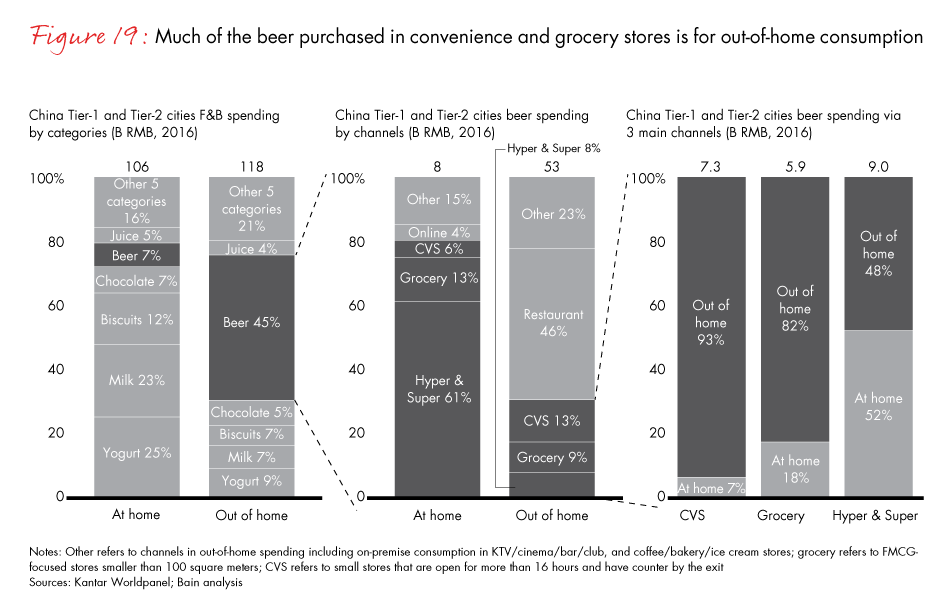
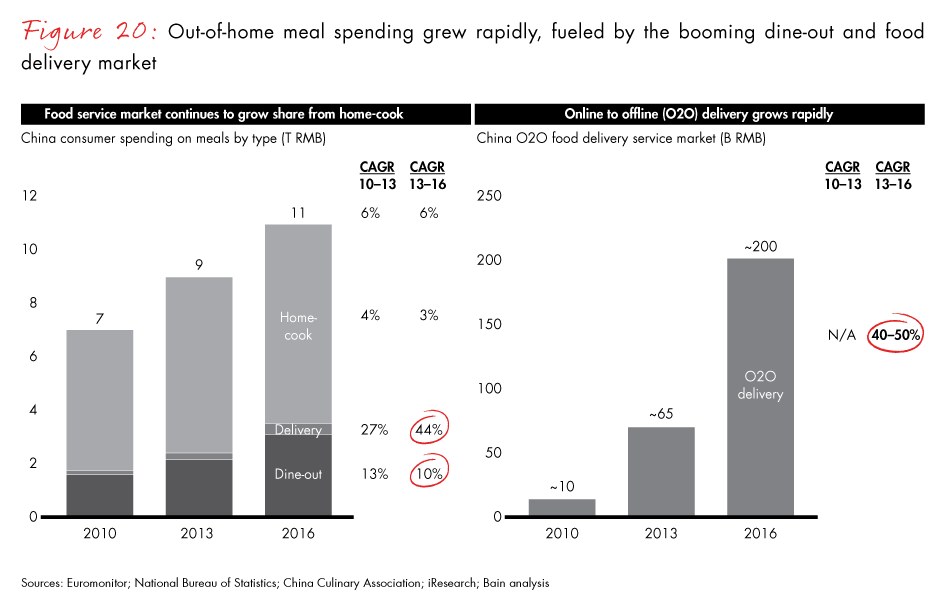
Implications for brands and retailers
How brands can win
Reviewing their product portfolio to align with two-speed growth and embrace the dramatic retail changes. Companies need to review their business portfolios to examine their high-speed and low-speed mix of product categories and channels. Companies with all products falling into low-speed categories and channels have no choice but to embark on a transformation.
Adapting their product ranges to capture new consumer needs. In this report, we have seen the continuous strong demand for healthy, quality products, as well as the huge potential for out-of-home consumption, including dining-out and delivery. Companies can invest in research and development (R&D), supply chain (e.g., cold storage) and product design (e.g., to create packages for on-the-go consumption), and can target the right customer segment (e.g., B2B food service) to catch the wave of Chinese consumers’ new needs.
Continuing efforts to develop digital capabilities and more broadly design their business functions with a full- channel vision. As we’ve seen in our six years of studying purchasing behavior for China Shopper Reports, e-commerce is continuously showing strong growth momentum, with lower-tier cities starting to catch up on penetration and spending. The era of massive expansion of physical stores is over. Companies that are traditionally strong in the offline channels in lower-tier cities now face increasing pressure from competitors penetrating these cities via online. They need to focus on building their own digital capabilities and to defend their ground by activating the online channel. Companies need to design their business functions with a full-channel vision to win the future Chinese shoppers who are becoming increasingly sophisticated and multichannel.
How retailers can win
Adapting their customer strategy to capture the high-speed growth of the digital and O2O business. Instead of losing market share and penetration to online, traditional offline retailers need to capture the opportunity by creating a closer linkage with e-commerce. Among the approaches: collaborating with O2O delivery aggregator platforms, accepting mobile payments, digital loyalty cards and quick response (QR) code vouchers in their stores, and marketing via social media. The ultimate goal is to create a digital-friendly, frictionless multichannel shopping experience.
Restructuring their store portfolio. Retailers can reduce the average size of existing hypermarkets and focus their space on prepared and ready-to-eat food, while offering food for delivery and introducing new, smaller, convenience-type store formats.
Revamping store designs to prepare for the huge potential in out-of-home consumption. Convenience stores and traditional grocery shops can benefit from their central locations by redesigning the store format (for example, to have more shelf space for prepared food, or to have more cold storage space for beer and juice) to accommodate the larger consumer demand for food and beverages consumed on the go.
About the authors and acknowledgments
Bruno Lannes is a partner with Bain’s Shanghai office. Jason Ding is a partner with Bain’s Beijing office. Marcy Kou is CEO at Kantar Worldpanel Asia. Jason Yu is general manager at Kantar Worldpanel China.
Acknowledgments
This report is a joint effort between Bain & Company and Kantar Worldpanel. The authors extend gratitude to all who contributed to this report, in particular Carrie Zhang, Yanhong Ding, Karl Zhou and Minghui Jia from Bain; Rachel Lee, Tina Qin and Robin Qiao from Kantar Worldpanel.
1These 26 categories are a) packaged food: biscuits, chocolate, instant noodles, candy, chewing gum and infant formula; b) beverages: milk, yogurt, juice, beer, ready-to-drink (RTD) tea, carbonated soft drinks (CSD) and packaged water; c) personal care: skin care, shampoo, personal wash, toothpaste, makeup, hair conditioner, baby diapers and toothbrushes; and d) home care: toilet tissue, fabric detergent, facial tissue, kitchen cleanser and fabric softener.
2Penetration is defined as the percentage of households in a market buying a particular brand in a given year.
3Online penetration is defined as the number of people who bought online at least once per year divided by the total population.
4The Founder’s Mentality® consists of three main traits—an insurgent mission, an owner mindset and obsession with the front line. In their purest expression, these traits can be found in companies that are founder-led, or where the clear influence of the founder still remains in the principles, norms and values that guide employees’ day-to-day decisions and behaviors.
5The 11 categories are beer, packaged water, RTD tea, juice, CSD, biscuits, chewing gum, chocolate, candy, milk and yogurt.
Founder’s Mentality® is a registered trademark of Bain & Company, Inc.



















